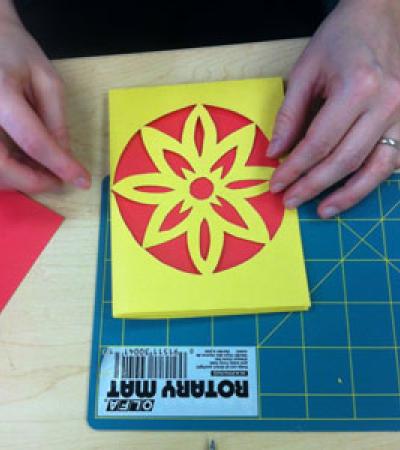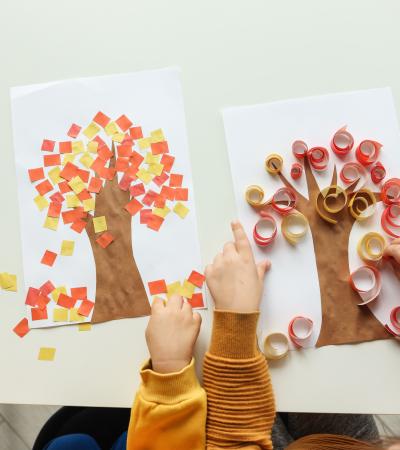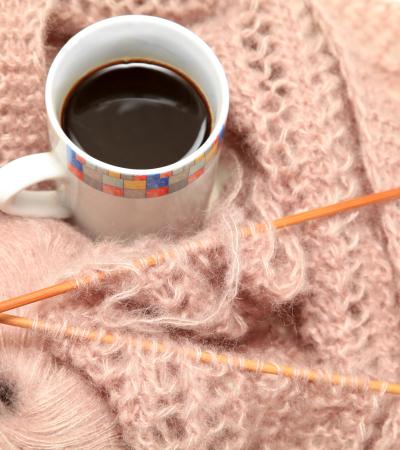This series of craft workshops, offered monthly since 2012, offers a wide range of recreational arts and crafts projects for adults of all ages. The projects are selected to be completed in a hands-on workshop, which lasts between 90 and 120 minutes.
These sessions vary each month in the type of materials, techniques and skill level required, and everyone walks away with a finished utilitarian item at the end. Each of the maker projects use lower-tech equipment and skills in the arts. (View a list of Adult Crafternoon crafts under Attachments at right.)
Advanced Planning
We regularly research projects for Adult Crafternoons that use a variety of techniques and skill sets. Some examples have included sewing and needle crafts; beading and jewelry making; ceramics and mosaics; drawing and painting; and other more general craft projects. Throughout this series, we've found that crafts producing utilitarian objects are more popular than ones creating decorative items. We've also discovered that it's best if the project is something no one has tried before; this way, all participants start on an even playing field. The program is scheduled monthly, on the same day and time each month, allowing interested adults to anticipate their participation.
We find the crafts featured in this program series through online sites like Pinterest and crafting/DIY blogs. We also search craft books from the library's collections and arts and crafts magazines (like Cloth, Paper, Scissors; Quilting Arts; Wire Jewelry; DYI; Martha Stewart Living; and Real Simple) for ideas.
For supplies, the library has plenty of print materials that can be recycled for crafts. Craft and dollar stores are also great sources for inexpensive supplies. Reusable supplies, such as paintbrushes, scissors, pliers and other tools, have been purchased or donated and are kept for future projects.
Before each workshop, a sample of the completed project should be made to help participants visualize what they are going to create. Since there is rarely time for the instructor to create the project in class, samples of the partially completed project are also useful to have on hand to illustrate each of the steps during demonstration.
During the session, the instructor is available to assist the students on an individual basis. A copy of the directions, any templates required and a list of resources are given to each student to take with them at the end of the class.
Marketing
The library advertises all program opportunities and activities in an online event calendar, a bimonthly newsletter and branded fliers. The fliers are created and displayed in the library, other municipal buildings and posted on the library webpage, which is linked to social media. There are separate sections for children, tween, teen, new adults (what we call our 20-somethings) and adult programs. The most effective promotion is an email blast using Constant Contact, which is sent a few days before the program date.
Budgeting
The funding for these projects is provided by our Friends of the Library group, which reimburses the programming librarians for their submitted expenses. When more store-bought materials are required for a project, we sometimes charge a nominal materials fee ($5) to each participant.
Day-of-event Activity
The library has a dedicated craft room where these types of activities are scheduled. This is a separate space from our high-tech makerspace. The room is equipped with moveable tables and stacking chairs, a sink for clean-up and storage cabinets to hold supplies. The configuration of tables is arranged to encourage conversation, sharing of ideas and easy access to assistance.
Before the workshop starts, the components of the project are set out and some pre-assembly is done so the project can be completed in the allotted time. It is important, just as it is with children’s projects, that the participants leave at the end of the session with a completed item. Bags, such as grocery bags, should also be available to help participants carry the items home.
Program Execution
Whenever possible, the instructor gives step-by-step instructions to the class using the original source guidelines. Once the instructor gives directions for a step, they should make themselves available to give individual assistance, as everyone works to complete that step. As the instructor guides the group, it's helpful to have pictures available of what is being created and, if possible, ideas for variations.
Participants generally prefer when a certain amount of individualization to the craft is permitted — for instance, to allow the student to select the color scheme or shape of the final project. However, it's easier to provide instructions for a craft if less individualization is allowed. Still, I would still recommend giving participants some opportunity to personalize their finished piece.
We determine the effectiveness of this series by the number of repeat students and the comments they make. No formal evaluation component is used for these kinds of programs.
Advice
Craft programs for adults have been popular in our library for the last five or six years. The first year I started offering this series, the collaborative summer library program (CSLP) theme was "Master the Art of Reading." During this summer, I offered a series of drawing and sketching classes, which were well attended. Since then, I have been doing a crafternoon program monthly.
I have found that adults have widely different skill sets; frequently, a class will contain some proficient crafters who will want a challenge and others who are not so experienced or capable. This has been an issue in selecting the projects. They can’t be so simple that the skilled crafters will be bored and can't be too difficult, or they will cause frustration for the beginners. I have been thinking lately about having a difficulty level assigned to each program such as beginner, intermediate or advanced, but that would require more time devoted to creating more programs.
I generally keep the classes at 10 to 12 participants. If there are too many students, it makes individual instruction more difficult.
Additionally, when planning for the event, make allowances for the amount of time each person needs to complete each step. I try to make sure that the quicker learners are able to progress and are not waiting around for the next step. The main goal is that everyone have a good time and look forward to coming back again.
Supporting Materials
- Feedback (Coming Soon!)
- Programming Librarian Facebook Group




